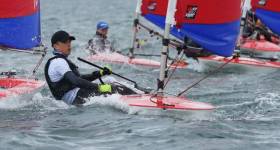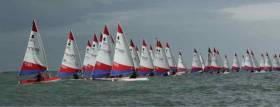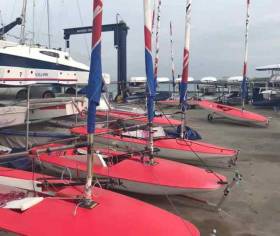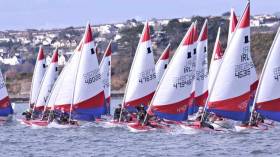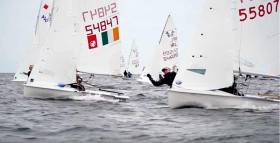Displaying items by tag: Topper
Royal Cork Yacht Club Laser & Topper Frostbites Underway in Cork Harbour
After three races of the Royal Cork Yacht Club Laser 4.7 Frostbites, Dawson Kohl leads from Peter Layton in a 16-boat fleet. Third is Daisy Seward writes Bob Bateman
In the Laser Radial division, Chris Bateman leads Atlee Kohl with Sophie Crosbie in third in the seven boat fleet.
A 12-boat Topper 5.3 fleet is lead by Neil O'Leary with Darragh Collins in second and Cian Mc Donagh third.
See photo gallery below. Results are here.

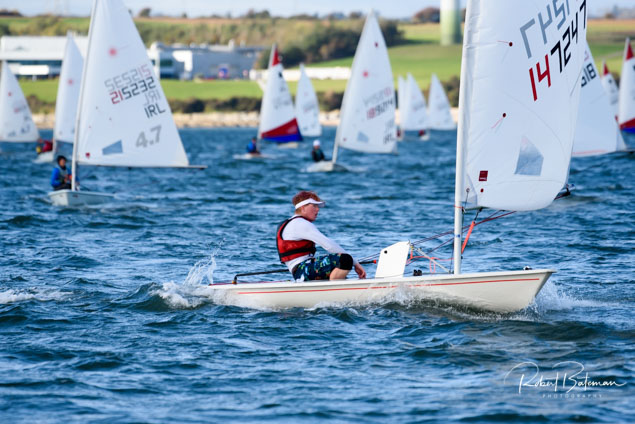
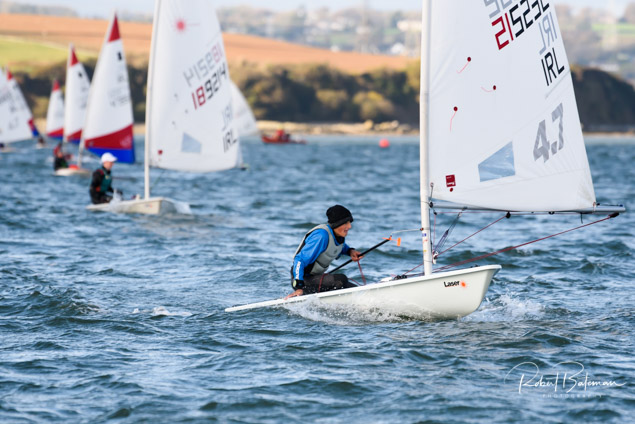
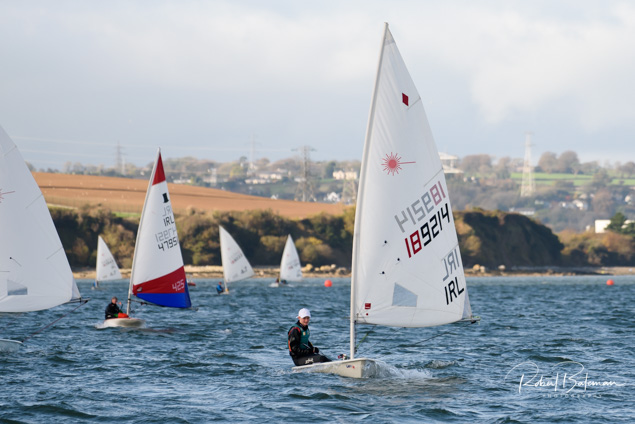

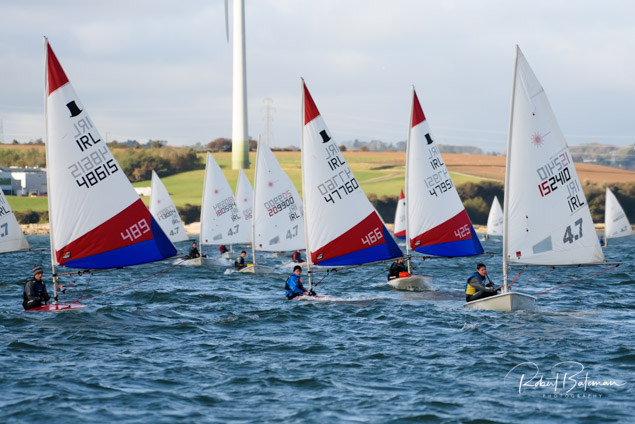


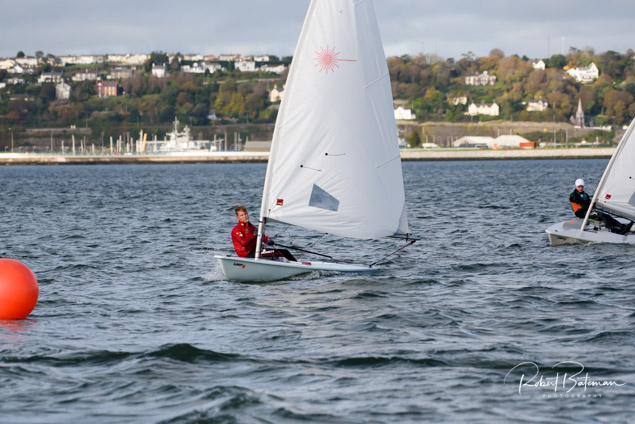
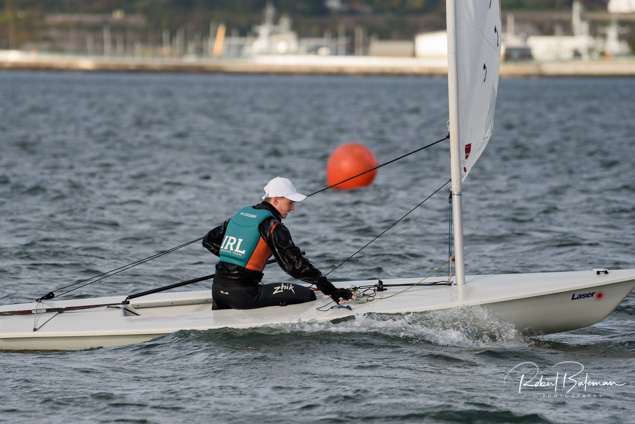

Nine Topper 4.2 Race Wins for Rian Collins of Royal Cork
The Topper Ireland Nationals were held at the Royal North of Ireland Yacht Club on the banks of Belfast Lough last weekend writes Joe Seymour. Over 50 sailors from all parts of Ireland and 10 from the ITCA (GBR) / RYA British Youth Sailing Team were in attendance making it a highly competitive event. While the winds were not strong they were constant over the 3 days and 9 good races were completed.
In the 4.2 fleet, Rian Collins of Royal Cork continued his winning streak with 9 bullets over the 3 days. In the 5.3 fleet the wins were spread out between the top 4 sailors, with Tim Evans (Grafham Water SC) emerging as the Overall Winner, followed by Hugh Lynch (RCYC, pictured above) who was second and overall Irish Champion. Hannah Dadley-Young (Ballyholme YC) finished as First Lady and sixth overall in another impressive performance for this Junior Sailor, which included two second finishes.
RNIYC put on an impressive show for all the visitors with over 60 volunteers ensuring that the event went off without a hitch.
Topper racing now relocates to the Medemblik in the Netherlands for the Topper World Championship on the 22 to 26 July. Over 20 Irish sailors will be participating, and boats are already on the move to Holland with sailors arriving next week. We look forward to reporting on their progress in the coming weeks.
Joe Seymour is Topper Ireland Chairperson
Good Weekend for Topper Sailors at Dunmore East
The Topper Ireland Southern Championships were held in Waterford Harbour Sailing Club in Dunmore East this past weekend, 22-23rd June.
59 competitors sailed six races over the course of the weekend in varying conditions - from beautiful sun and nice brisk sailing winds on Saturday – where the organisers managed to get 4 races in, to heavy rain and a big swell on Sunday to make it much more challenging for the final 2 races.
WHSC did a great job of making the sailors welcome and had a fantastic team of volunteers available both in and around the club itself, and also around the roads to direct visitors around the roadworks. They hosted a BBQ in the Club on Saturday night, which was enjoyed by many of those visitors.
It was also great to see so many sailors who are new to the Topper fleet competing in the championships, including new young sailors in the established clubs and also many sailors from smaller clubs who have not been active in Toppers for the past few years. The prizes were spread across the Country, but particular mention of the Collins Brothers from RCYC, Rian winning the 4.2 fleet and Darragh winning the 5.3 Fleet, and Hannah Dadley (Ballyholme YC) who was First Lady and is still in the junior age category.
The Closing Date for our premier event of the year, the 3-day National Championship, is 28th June. This is to be held at the Royal North of Ireland Yacht Club, Holywood, Co. Down on the following weekend of 5-7th July, with boats from throughout Ireland and some of the top sailors from the UK expected to be in attendance.
As Afloat.ie previously reported, fifty keen junior sailors from all four provinces took to the waters of Dubin Bay over the weekend as the National Yacht Club, with the support of Viking Marine, hosted Topper Ireland’s third annual Winter Regatta writes Jo Seymour.
Despite heavy overnight winds the wind dropped off as Saturday morning progressed, allowing the sailors to take to the water for Eddie Totterdell to oversee 3 clean races over both the full rig and 4.2 rig fleets, in spite of the wind dropping off at times, and shifting more than 90 degrees (meaning that, after small adjustments by the mark layers between races 1 and 2, a full reset of the course was needed for the final race).
On Sunday the Spring Chicken sailors headed to the Muglins in murky conditions, but it lifted to allow the Toppers a clear race area back off Seapoint. While the first race went off on time, the wind came up earlier than expected and the visibility dropped again so racing was abandoned to bring the sailors to shore. But once hot chocolate, warm showers and food was dished out, the smiles were back and there was a great level of chatter around the deck of the NYC as various fleets of sailors mingled as they waited for the prize giving. A bucket on the table raised a nice donation for the local RNLI station as well.
Prizes went all around the country, and included perpetual trophies for the top sailors – Eoin Horgan (RCYC) in the Youth Male, Emma O’Sullivan (RCYC) in the Youth Female and Charlie Patterson (East Antrim Boat Club) in the overall 4.2 categories. But overall it was a great first gathering of the friendly Topper Community, hoping for a great sailing year ahead. The next event is the first “Traveller” in Quoile Yacht Club, Downpatrick on Sunday 14th April and we are all looking forward to that.
Full results are downloadable here.
Royal Cork Sailors on Top at Topper Winter Regatta at National Yacht Club
The Viking Marine sponsored Topper Winter Regatta at the National Yacht Club in Dun Laoghaire attracted a record turnout for a four-race, one discard event. As Afloat.ie previously reported, sailors attended from across Ireland.
In the 43-boat Topper Full rig class, Royal Cork Yacht Club youth sailors made a clean sweep of the podium. Eoin Horgan beat Cillian Foster by a single point for the overall title with Emma O'Sullivan in third place.
In the 4.2 class, Charlie Patterson from East Antrim Boat Club took the honours in a seven-boat fleet from Clontarf Yacht & Boat Club's Ella Fitzgerald.
Download full results below.
Viking Marine Winter Topper Regatta Set for Record Fleet Size at National Yacht Club
With sailors coming from all over Ireland and a favourable weather forecast, Irish Topper agent Viking Marine is sponsoring this weekend's Winter Youth sailing event hosted by the National Yacht Club in Dun Laoghaire.
With up to 50 young sailors expected, it clearly shows the popularity of this pathway boat especially amongst sailors transitioning out of the Optimist class, Viking's Ian O'Meara told Afloat.ie.
"Up to 50 young sailors expected"
‘We have had great success with all boats across the Topper range and Topper are a world-class company to work with,’ O Meara says. ‘Great boats, great back up and service and constant innovation as seen with the new 6:1 kicker upgrade kit. Sailors are loving this recent innovation from Topper giving the kicker far greater power’.
Viking Marine is open all weekend with sales assistants Conor and Saoirse on hand to assist competitors and families in need of Topper equipment and kit
Young Irish Topper Sailors Head For China
It’s great to see young sailors enthusiastic about the sport. Watching Topper dinghy sailors training for their big challenge, with determination and focus, is encouraging. The sport has a future if it can hold onto young sailors.
This weekend young sailors of the 11-foot Topper dinghy from Cork, Dublin and Northern Ireland, will set off on the biggest challenge of their lives so far – heading to China to race in the World Topper Championships.
The boat was designed by Ian Proctor and has gained popularity around the world.
Two hundred and sixty-five sailors from twenty-one countries will be competing at the Topper World Championships. The Great Britain Team are sending 65 sailors and amongst the other countries participating will be France, Italy, Hawaii, Germany and a strong contingent from China where the boat has become very popular in the past few years.
The Royal Cork Yacht Club at Crosshaven has 35 Toppers which, its Class Captain says, is the biggest Topper dinghy fleet in Europe. The club is sending a team of fifteen of these young sailors to the Topper World Championships in China, which will be sailed next week. Another 14 Topper sailors are due to travel from Dublin and Northern Ireland clubs.
Diarmuid Lynch is the Class Captain and says their involvement at the World Championships in China will be a good representation of Ireland by young Irish sailors.
The Royal Cork will have the largest club representation and for this week’s Podcast, Diarmuid Lynch has been telling me that it is a great challenge for the young sailors who are hoping to achieve good results for Ireland.
• Listen to the podcast below
Topper Class Appeals For Parents To Join Committee
#Topper - The Irish Topper Class Association is appealing for parents of class members to join its committee for 2018-19.
“Every year, as sailors move on to other classes, so do most of the parents who have served on the committee,” said the class in a statement on social media.
“The class only exists because of parental support, so if you feel you would like to help next season, please chat to any of the committee members or drop an email to Nicola at [email protected].
“For the majority of positions, you do not need any sailing knowledge, just a willingness to help.”
Viking Marine Become Topper Dinghy NI Dealer
Viking Marine has taken over the Northern Ireland dealership for Topper Sailboats after Wiclif McCready's retirement from his Hollywood, County Down Chandlery Shop.
Topper sailboats offer a wide range of best selling and favourite dinghy boats. The collection includes the iconic singlehander Topper, the versatile Topaz, the high-performance catamaran Topaz 16 and the multi-purpose Omega.
Viking Marine has been in close talks with Topper and with Brian Spence from McCready's sailboats to ensure a smooth transition. Brian will be working with Viking Marine in the future to add to our expertise and to liaise with existing Northern Ireland customers.
"We are pleased to become Ireland and Northern Ireland's Topper official dealer. As we have been Topper Ireland's dealer for many years, we are ready for this new challenge." says Ian O'Meara, of Viking Marine. "We are happy to have retain the expert advices of Brian. We look forward to work with him and welcome new customers."
For more information on the Topper boats, contact Ian O'Meara on 01 2806654.
Talent Spotters Focus on Irish Sailing Youth Pathway National Championships on Dublin Bay
There’ll be three race courses, five classes, three evening talks, and 32 counties represented at next month's Volvo Irish Sailing Youth Pathway National Championships taking place 5th – 8th April 2018 in Dun Laoghaire, jointly hosted by the Royal St George Yacht Club and the National Yacht Club.
As well as great racing on the water, and good fun at the club ashore. The evening talks as well as the races are open to all young sailors who sail in the five Irish Sailing Youth Pathway Classes (Laser Radial, Laser 4.7, 420, Topper and Optimist). This is Ireland’s largest Youth regatta and Irish Sailing’s primary talent spotting event of the year for the Academy and Junior classes.
Importantly it’s also one of the few chances in the year when family and friends who are sail in different classes can all sail together at one regatta venue, competing on different courses but on the same waters, giving a brilliant opportunity for shared experiences, learning and fun.
Up to six places on the Irish Sailing Laser 4.7 Squad: Up to six sailors will be chosen at the Irish Sailing Youth Pathway Nationals to join the Irish Sailing Laser 4.7 Squad. The squad will provide training to help young sailors transition in the Laser 4.7 class. It will also aim to prepare and support the squad for the Laser 4.7 World Championship to be held in Gdynia, Poland in July. The squad coach and programme will be announced following the event. Entry to the Laser 4.7 Worlds is independent of Irish Sailing squad selection through the International Laser Class Association.
The four days of racing in Dublin Bay will decide the six places on the 420 European team who will travel to Sisimbra, Portugal in July to compete in the 420 Junior (U18) European Championships.
Irish Sailing Laser Radial & 420 Academy: The Irish Sailing Youth Pathway Nationals is an indicator event (amongst other factors including domestic and international events) for the Irish Sailing Youth Academy. The Academy undergoes a review biannually following the Youth Pathway Nationals and in the autumn each year.
IODAI Irish Optimist Trials: The Optimist trials fleet will take to the water to compete for coveted team spots at the 2018 international regattas. Places for the World Championships in Cyprus, the European Championships in the Netherlands, and the international development team events in both Poland and France are all up for grabs.
Topper class: The Topper World Championships take place in China this year with a strong Irish team travelling to the regatta this year. The Pathway Nationals will provide a good indicator of form as the sailors test themselves against the best in the country as they head into the spring period of their season.
A lineup of evening speakers – open to all: At 5.30pm each evening there will be a talk and Q&A session at the nominated club with speakers who have a deep knowledge of racing. The talks are open to all sailors and parents.
• Thursday 5th – Saturday 7th April, Ross Killian & Sean Evans. Each evening Ross and Sean, the Irish Sailing Performance Coaches will give video analysis and coaching tips from the day’s racing
• Friday 6th April, James O’Callaghan Irish Sailing High Performance Director will talk through the Olympic and Performance Pathway
• Saturday 7th April, Jessie Barr, Sport psychologist currently working at the Sport Ireland Institute. Jessie is a four-time 400m relay Olympian. She has worked with a number of the Laser and 420 Academy sailors.




























